Space Talk: Missions Through Time
Izzie Clarke and Katie Haylor are blasting through a brief history of space exploration and find out how humanity's quest towards the stars has inspired their guests, who are space journalist Stuart Clark, Big Big Train band memebrs Greg Spawton and David Longdon, and former Commander of the International Space Station, Chris Hadfield. Plus, news of an app for anaemia, the shocking genetic experiment that’s rocked the world, and the latest on how gravitational waves are ushering in a new era of astronomy...
In this episode

00:52 - An app for anaemia at your fingertips
An app for anaemia at your fingertips
with Robert Mannino - Emory University
Almost two billion people worldwide are affected by anaemia: they have too few red blood cells; this often needs to be monitored, but that monitoring is inconvenient, time consuming and costly. Cue Emory University's Robert Mannino, who spoke to Chris Smith and has a solution - literally - at his fingertips…
Rob - This technology was developed and motivated by the fact that I myself suffer from serious anaemia that requires me to receive regular blood transfusions. And as part of that I get my anaemia levels checked quite frequently. Doing this involves me getting myself to the hospital, waiting around in the waiting room, getting a venous blood draw. So getting stuck. And then waiting for my doctor to tell me the results. And I thought there would be a better way to do this.
And so I have developed a smartphone app that's able to measure the color of someone's fingernails and correlate that color to a person's haemoglobin level. Now haemoglobin is a protein that's found in the blood, gives blood its red color and it's responsible for transporting oxygen throughout the body and low haemoglobin levels are what defines anaemia.
Chris - And the low hemoglobin levels they're reflected in changes in the fingernails how exactly? What are you looking for?
Rob - We're looking for the colour so because haemoglobin is what gives blood its red color, someone with low haemoglobin levels will have paler fingernails.
Chris - So how does it work then? What, you literally take a picture of your fingernails, capture the image and then process the image with the app and it extracts the colour and that's what tells you roughly what your haemoglobin level will be?
Rob - Yes exactly. A user can download the app on their phone and simply take an image of their fingernails. Based on the colour of their fingernails the app gives an estimate of the haemoglobin level.
Chris - How good is it Rob? Is it highly reproducible? If I did this 10 times on myself would it return the same haemoglobin estimation each time?
Rob - So we've shown our results to be on average within plus or minus one gram per deciliter of the gold standard tests for measuring haemoglobin levels. And that's right around plus or minus 10 percent.
Chris - And is that good enough is 10 percent good enough for someone with a condition like yours who needs to know what their hemoglobin level is? Would you be comfortable with 10 percent either side?
Rob - So right now the app cannot be used to diagnose or treat conditions, but the accuracy is acceptable in our opinion for screening. So someone getting an idea of whether or not they should seek treatment based on the results.
Chris - I presume that the system would be frustrated by nail varnish unless it was clear. But what about other defects, lesions, these things, these white marks that we get on our fingernails. Can it get caught out?
Rob - So you've actually hit the nail on the head with that one. Yeah it certainly won't work with nail varnish or nail polish as and like you mentioned certain fingernail bed irregularities can impact the results. Patients with white spots on the fingernails or maybe nail bed injuries would not be able to use the system if a significant portion of their fingernail beds are obscured.
Now I'm in the process of developing quality control methods to try to ignore spots and regions on the fingernails like that.
Chris - The follow on from that is that a significant number of people who have haemoglobin problems linked to anaemia often have dark skin. I'm thinking about conditions like sickle cell anaemia which tend to be in black Africans. Do people with black skin have a problem with your app or is it colour blind as it were?
Rob - So that's actually the great thing about using the fingernails. Under normal circumstances in the fingernail beds there are no skin cells that produce pigment. So in normal circumstances regardless of the subject's skin tone, the colour of the fingernails should be the same. And so we actually did studies with patients for many different skin tones and being in Atlanta Georgia, we actually have a fairly large sickle cell disease population who was included in the clinical studies that we did and we didn't show any correlation between skin tone and error.
Chris - Given that you've got this technology working you can capture an in future you're saying you'll be out a better capture images of the nail bed and extract colour information, could you use this diagnostically or as a screening tool for a range of diseases, not just anaemia? Could you extend this to other possible conditions because we know lots of diseases do manifest with changes in the nails?
Rob - Yes absolutely. So we chose anaemia because anaemia was really the low hanging fruit so to speak. But really this technology could be applied to any condition that manifests in a physical change or discoloration of the fingernails. Jaundice where regions of the body get a yellow color. Some heart conditions manifest in something called cyanosis where the fingertips become more blue due to circulation issues.
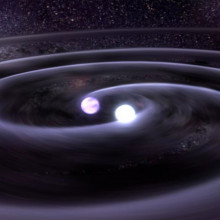
06:35 - Gravitational Waves: A new era of Astronomy
Gravitational Waves: A new era of Astronomy
with Shane Larson, Northwestern University
Predicted over 100 years before they were detected for the first time in 2015, gravitational waves won Nobel Prizes for their discoverers and further validated Einstein and his General Relativity theory that said they should exist. Since 2015 the detectors - long tunnels resembling giant letter Ls - have continued to operate and the scientists working on them have been picking through the cosmic hubbub they've recorded. And from that data they've been able to tease out evidence of further gravitational wave events corresponding to pairs of black holes merging and neutron stars colliding. It's ushering in a new era of astronomy. This week four more events were announced, and Chris Smith caught up with team member Shane Larson to hear how it’s going…
Shane - When stars reach the ends of their lives, they become these very compact stellar skeletons called a black hole: An object which is so gravitationally strong that nothing can escape it. These stellar skeletons, they lie around in the cosmic graveyard together and sometimes they find each other. They orbit around each other and merge to form a bigger black hole. And we can detect those with these gravitational wave detectors LIGO and Virgo.
Chris - Now you made the first announcement of this happening back in 2015 - 2016 and since your first observation run you've added another detector now, so you're actually detecting with three different observatories aren’t you?
Shane - Yeah. So the network right now is the LIGO observatories. The two of them in the United States one in Hanford, Washington and one in Livingston, Louisiana. And then the European gravitational observatory called Virgo which is outside Pisa, in Italy.
Chris - And how do these detectors do what they do?
Shane - We call them observatories because we're doing astronomy, we're observing the universe, but they are not telescopes in the sense that we're used to thinking about astronomy. They're laser interferometers. So we basically use lasers. There are these gigantic Ls and the lasers go in two directions down what we call the arms. And these gravitational waves, when they come through the detector, they change the lengths of those arms and we can sense that by timing, how long it takes the laser to go down to the end of the arm and back again.
Chris - Given that these changes are going to be really subtle, excruciatingly tiny changes in the lengths of those arms, which are kilometers long aren’t they, on these observatories. How do you actually detect a difference that minute?
Shane - Gravitational waves, they warp the shape of the detector in a very definitive way. They tend to take one of the arms and make it longer at the same time that they take the other arm and make it shorter. And so we look for that consistent pattern between the two arms to be confident that we're seeing something from this cosmic event.
Chris - How do you actually know that that corresponds to a couple of black holes that were twirling round each other now coalescing to make a big black hole?
Shane - Everything that generates gravitational waves makes a very specific pattern of waves depending on the mass, as well as how that mass is moving relative to other things around it. Black holes look different than, say, neutron stars because black holes behave differently when they get close to each other than neutron stars do.
So we look at the shape of the waves and the shape of the waves encodes in it what made the waves, and so this is very analogous to the way we do astronomy. Traditionally, when you look at a star through a telescope the light encodes all the information about the star. When I look at the light from a star I can tell how hot it is based on the colour of the light. I can tell how fast the star is rotating based on whether or not the colour of the light is shifted towards the red or shifted towards the blue, right? All of that information is encoded in the bit of information that we get. And our job as astronomers, whether were astronomers who use light or astronomers who use gravitational waves, is to understand how to extract that information from the waves that we get.
Chris - And how far away are the detections that you're describing in the new papers?
Shane - The new detections are some of the most distant gravitational wave sources that we've detected so far. They're, kind of, 3-4 billion light years away from Earth.
Chris - That’s quite a long way isn't it? Now, some people though, actually quite reputable people, have said that actually you've got your sums wrong and they've been a number of headlines saying that, actually, what you're seeing isn't gravitational waves it's actually noise in your apparatus or some other explanation for the signals you're seeing. Have they got a point?
Shane - The core root of all science is intense scrutiny by our colleagues and our understanding of our data in response to that scrutiny. We are very confident that the detections that we've made are all detections, for a variety of reasons. We have multiple detectors that all see the same thing. And now with the release of this new catalog we have 10 different binary black hole events that all agree with the behaviour for black hole gravitational wave emission.
So we're confident that these events are definite astrophysical events. There's an additional measurement that we made last summer, where we detected the gravitational waves from a binary neutron star merger. So a neutron star is a slightly different kind of stellar skeleton. It's not quite as dense as a black hole but it still results from a star dying. And what's important about that detection is, we detected it both in gravitational waves and with telescopes. So we have extraordinary confidence in that detection because we've confirmed it using very traditional astronomy methods as well.

The Evolution of Skin
with Eva Higginbotham
It’s time for a mythconception and this week Eva Higginbotham has been picking apart the science of skin colour.
Eva - From very pale to very dark, modern-day humans have a whole range of skin colours. And that’s just because having dark skin is better in hot countries to prevent skin cancer, and having light skin in cooler countries is better for making that essential vitamin D, right? Well, this is true, but it doesn’t actually explain how we evolved the variety of skin colours that we see today. Even with lots of time in the sun, you’re not too likely to get skin cancer until at least middle-age - and because evolution is all about who survives long enough to pass on their genes to the next generation, whether or not you got skin cancer by the time you had grandchildren shouldn’t really matter in an evolutionary sense. So, what’s the real story?
Before we were actually ‘humans’, we started off in Africa with pale pink skin covered by a generous serving of fur. And our expansive body hair did the hard work of protecting our skin from the sun’s strong UV rays.
As we started losing our fur our skin gradually darkened, and this was to protect us from UV radiation. But, it wasn’t just to prevent skin cancer, the main reason we needed protection was to preserve our folate - a vitamin that is absolutely essential for a healthy life as a human, especially if you want to reproduce. For pregnant women is it exceptionally important, as a lack of folate during pregnancy can lead to serious spinal defects.
And importantly, UV radiation is very good at breaking down folate. So if you were an early human living in Africa and you had pale skin, you weren’t going to be making too many babies because your folate would be constantly depleted by the hot sun. But, if you had darker skin, you were more protected from the sun’s UV rays and so able to hold onto your folate better, increasing your fertility and making it more likely that you’d have a healthy baby. Our darker skinned forebears had the evolutionary edge over the lighter skinned as a result, and so by the time our ancestors had evolved to be homo sapiens, the species we are today, everyone had dark skin.
So, the reason we evolved dark skin in the first place wasn’t really to do with preventing skin cancer, the much more important factor was that having darker skin protected people from depleting their folate. Now, once humans started dispersing around the globe to countries with weaker sunlight, they had to balance the need to protect their folate with their need for vitamin D - another essential vitamin for humans which needs the opposite of folate, lots of sunlight! And ultimately, the range of skin colours we see today all come from the competing needs to protect our folate and make our vitamin D, not to stop us getting skin cancer. Still, since we are living much longer nowadays, it’s best to not skimp on the suncream when getting out and about in summer sun.

15:56 - Controversial CRISPR Babies
Controversial CRISPR Babies
with Anna Middleton, Wellcome Trust
The world of genetics has been rocked this month, with the announcement from a scientist called He Jiankui at China’s Southern University of Science and Technology, in Shenzhen, that he’d been using the experimental DNA editing system, called CRISPR, on human embryos. The modified embryos were implanted and a pair of twins carrying the genetic changes have allegedly been born. If this is true, it’s a monumental milestone but has totally run against what the community considers safe and ethical. Now, the scientist involved has since vanished, and his website has been taken down. So did it really happen, and what’s the fallout going to be? Georgia Mills caught up with Anna Middleton - head of society and ethics research at the wellcome genome campus in Cambridge...
Anna - This has not been published in a peer reviewed journal so we're not entirely clear if it's true or not, but I was at the Hong Kong summit where it was announced and it seems credible that it may have actually happened. Of course, then, the next questions are, well, how could this possibly happen? Because the implantation of edited embryos is illegal in many countries across the world and it just raises so many ethical questions. My mind is absolutely blown with questions for these researchers as to how they did this and how they got away with it.
Georgia - What kinds of things would you like to ask them? And I suppose where have they crossed the line?
Anna - Well I did actually get a chance to ask them. So I stood up and said ‘Could you tell us about the consent process?’. Because the first point in any research like this is to understand if the research participants themselves actually understand what they're getting into. And it seems from the consent form, which has actually now disappeared from the internet but we've managed to have a look at it before it went, advertised the research project as a vaccination against HIV.
So it wasn't being touted as a project about editing of embryos - in the small print the embryos were mentioned. The only consent form that’s actually available that we've seen is in English and the participants, as far as I understand, were Chinese; and the form is full of legal jargon and scientific jargon and if you put it through a readability school you'd need at least a degree to understand it in written English.
I think the first point is we could probably say with confidence that the participants didn't understand what they were taking part in. Consent - that's the first issue. Research into editing of embryos around the world isn't illegal, but what the common kind of guidance is that we don't implant them to lead up to pregnancy and the embryos are destroyed at the 14 day kind of mark. To actually implant them with the intention of leading to pregnancy is highly unethical, really because we don't fully understand the downstream effects of this editing and whether there could be extreme harm induced - particularly in these embryos. You know, you go to edit one gene, and other genes you inadvertently edited at the same time and all the science in this has not been fully completed yet.
Georgia - Right, and I suppose doing something so dramatic you'd expect it to be for something lifesaving in the embryo, but this was something different.
Anna - Yes absolutely. So these embryos were completely normal up to the point that they were edited - you know, it wasn't like he was trying to get rid of a really serious genetic disease that the embryos already had. They were completely normal.
Georgia - What was the reaction like in the room when this got announced?
Anna - The reaction was palpable. There was a gasp. There was a silence. People were just shocked. It was really incredibly powerful and the sort of elite of medicine ethics and science were there in the room, and there was just a sense of absolute disbelief. How could he do this? Which research ethics committee approved this? Has he got ethics approval? How is this funded? Where was this done? And it turns out there's questions about all of those things now.
Georgia - Do you think this is gonna be the tip of the iceberg? You know, is CRISPR a runaway train that we're just not going to be able to stop?
Anna - That's the big fear and if you look at the rogue stem cell clinics that are popping up around the world - where the earth is promised to terminally ill people, ‘come and have a stem cell transplant!’ And you know lots of money is exchanged, and this is not leading to treatments or cures for people. It feels as if there could be the same industry around editing of embryos. But having said that, if we think about the process that you actually have to go through at the moment it's an IVF process, and that's not a straightforward process with a high very high success rate. So I don't know if there's going to be a mass market for this at the moment.
Georgia - Any idea what's going to happen to the scientist?
Anna - No, and from what I understand he's gone into hiding and the family has gone into hiding. We also understand there's another family with a pregnancy on the way, but of course they've all signed nondisclosure agreements so we'll probably never see them. Who knows what will happen to this scientist. I understand he has a large amount of cash backing him. So I don't know, maybe he'll just disappear into the commercial world and keep delivering his services - who knows. Depends on what the Chinese government decide to do.
Georgia - So this is a really liminal moment then; I guess 5-10 years from now, where do you think we'll be?
Anna - I wonder whether this is going to really push forward two things. One is tightening up the regulation. For those countries that don't have legal frameworks, maybe they'll put in place legal frameworks. But also I wonder whether the disease and patient community will push forward with their agenda on this.
What was really exciting to see was the Sickle Cell community and the Duchenne muscular dystrophy community at the conference, and you know they were saying look, we want somatic gene therapy. We want to understand how editing of embryos can help us. And it may well be, like with mitochondrial donation, they'll push for access to the services that they want and certainly in the UK that would require a change in the law. But that may be something that we start to work towards. I don't know but I think it will, you know, really catalyze conversations about this which is a really good thing.
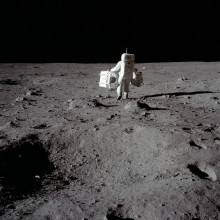
23:32 - Blasting through early space travel
Blasting through early space travel
with Rebecca Charbonneau, Whipple Library
Ready your rocket and buckle up, because this week we’re blasting through time and space. But when - and how - did we start star-hunting in the first place? Let’s travel back in time with Adam Murphy. Plus Izzie Clarke speaks to Astronomy journalist Stuart Clark about the impotance of Apollo 11.
Adam - For as long as humanity has been able to look at the stars we've dreamed of reaching out to them, from the tomb at Newgrange in Ireland, aligned with the summer solstice, to the ancient Greeks naming constellations. We've thought about touching the stars since time immemorial.
Rebecca - That's called the plurality of worlds or cosmic pluralism. This is people thinking philosophically on: is Earth the only world? If there are other worlds, are other people on them?
Adam - That is Rebecca Charbonneau from the Department of History and Philosophy of Science at Cambridge University who specializes in the history of aerospace. Now we've moved on quite a bit from the ancient Greeks and their plurality of worlds. When did those ideas turn into thoughts of really exploring skyward?
Rebecca - That's where we're going to come to Galileo. If you want to think of astronomy as using instruments that allow us to physically explore the cosmos, either with our eyes or with the machines that we build, I think Galileo was one of the earliest case studies of that. The history of the telescope is also kind of complex. Typically credit goes to a Dutch eyeglass maker named Hans Lippershey. He made what is essentially the refracting telescope. The following year Galileo heard about this technology, made some improvements on it and then used that to discover the moons of Jupiter, things along that line. That's where you start having exploration of these other worlds in that optically tangible sense.
Adam - Now looking up is all well and good but humanity has never been content to just look at mountains when we could be climbing them. How did we start moving into space ourselves?
Rebecca - That is much, much closer to the present era. We haven't been doing that for very long. If I wanted to start slightly earlier back I would take us to the late 19th and early 20th century. That's when you have what are known as the fathers of rocketry. In order to get people up there you first need to have means of getting up there. And so there are three so-called fathers of rocketry. In Russia and then the Soviet Union there was Konstantin Tsiolkovsky who wrote some of the first scientific papers on demonstrating that you could use rocketry in order to have spaceflight. Around the same time in the United States there was Robert Goddard who created the first liquid propulsion rockets. In Germany you have Hermann Oberth and he wrote books on potential of rocketry for spaceflight. Kind of around the same time period, at the turn of the 20th century, you have these three different men in three different countries positing on the idea of using rocketry for spaceflight.
Adam - And it may have taken a while but eventually... we managed it.
Rebecca - In April 1961 you have Yuri Gagarin, who was a Soviet cosmonaut. He was the first human being to both enter space and orbit the planet. He was proceeded by Alan Shepard, on the U.S. side of things, less than a month later. Alan Shepard however was only able to be launched into space, but was not able to achieve orbital flight.
Adam - This achievement began as something far more destructive - as V1 and V2 rockets used by the Nazis in World War 2, developed by a team of scientists led by Wernher von Braun. Other nations began to collect these rockets seeing the potential of this new technology. But von Braun also saw something more aspirational - manned spaceflight. He wasn't the only one.
Rebecca - Take for example Sergei Korolev in the Soviet Union, he was the chief designer of the Soviet space program. He's the one who was able to convince Nikita Khrushchev to put Sputnik on the top of their R7 rocket. It was these men individually influencing the government.
Adam - What about possibly the most famous space agency - NASA. How did that come into being?
Rebecca - NASA wasn't founded until 1958 and it was founded as a direct response to Sputnik. Sputnik was launched in October of 1957 and after Sputnik was launched this was really alarming. It was then an imperative to be able to compete with the Soviet Union on this level. In the New Year NASA was founded.
Adam - How successful was NASA at the beginning?
Rebecca - Actually NASA was not very successful against the Soviet Union in the early days of the Space Race. In fact the Soviet Union was able to accomplish a large number of objectives that NASA was behind on. Sputnik got the first object in orbit and then literally a month later Sputnik 2, which had Laika the dog also in orbit, so the first earthling in orbit, they were also able to accomplish the first person in space, the first person in orbit, the first woman in space. They were able to put the first manmade objects on the moon. The first nation to put manmade objects on other planets. There's a really long list of firsts and it wasn't until the mid 60s where the Soviet Union really started lagging behind.
Adam - America emerged the victors of the Space Race on the 20th of July 1969 when Apollo 11 put a man on the moon. But how did that change the way we see space and ourselves?
Rebecca - Well certainly if you look at the public side of things it really excited the public imagination. If you talk to anyone who was alive and conscious during the landing on the moon no matter what nation they're from they tend to be very excited and talking about how that was a really impactful moment in their lives. It definitely has a sense of seizing human imagination and that probably comes back to our roots in history and being fascinated with the idea of other worlds out there.
Katie - Rebecca Charbonneau from the Whipple Museum in Cambridge talking to Adam Murphy.
Izzie - Rebecca was also mentioning the Apollo 11 mission, which certainly was a giant leap for mankind. Joining us in the studio is Dr. Stuart Clark, astronomy journalist and fellow of the Royal Astronomical Society. Stuart, how difficult was it to get people on the moon?
Stuart - Oh tremendously difficult. It was a colossal undertaking and the way they approached it as well. Whilst obviously doing everything that they possibly could to guarantee the safety of the astronauts, they were not afraid to take a risk if that was the only way that they could do this in an efficient manner. Remember it really was a race to get there before the Russians. They balance that completely as they developed the program and the technology to get people there and back.
Izzie - Amazing as it was that we were able to get people there and bring them back, we then sort of stopped sending people to the moon. I mean it was thought that, in the 60s, we’d all be living on the moon in the future. Why did that come to an end?
Stuart - It really was tremendously expensive, the Apollo program. It was unsustainable. With the virtual collapse of the Russian moon landing program and America winning the Space Race, doing it enough times to show that it wasn't a fluke, that it was just something they could do with all the political points being scored in that way, then it was time to divert that money somewhere else.
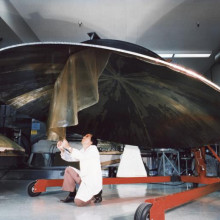
31:08 - Voyager: This Mission and Musicians
Voyager: This Mission and Musicians
with Stuart Clark, journalist, Greg Spawton & David Longdon, Big Big Train
Reaching the moon was certainly a giant leap for mankind to reach the moon but there were so many more unknowns further a-field. It was time for a mission to explore the outer edges of the solar system: Voyager. Izzie Clarke and Katie Haylor were joined by astronomy journalist Dr Stuart Clark and musicians, Greg Spawton and David Longdon, from Big Big Train.
Stuart - Yes. There were these two strands towards the NASA exploration program; one was the human missions, and I think generally people thought after the moon they go on to Mars and do all those kinds of things, and in order to do that they started to build these robotic spacecraft that they could send ahead and be looking at these worlds. And so whilst the outer solar system was not yet on the horizon for human missions - and still isn't - you still wanted to see it.
Izzie - With scanning our solar system, how did Voyager actually do that?
Stuart - Voyager did that by visiting in turn each of the four outer gas giant planets; Jupiter, Saturn, Uranus and Neptune. These are worlds that are utterly unlike Earth, they have no solid surface to speak of, they're just gigantic atmospheres. So they're truly alien worlds. And so we wanted to see those to understand what these kinds of giant worlds could actually look like.
Izzie - How did it begin? Was it always just to set out to look at two planets, or four planets, or what?
Stuart - Yes. In the mid 1960s a NASA engineer called Gary Flandro realised that there was an alignment of the four outer planets in the solar system and these planets: Jupiter, Saturn, Uranus and Neptune, they would allow a mission to visit each planet in turn. And this configuration of the planets would occur next in a hundred and seventy years. It was a case of now or never.
NASA went for it. They designed a mission concept called “The Grand Tour” and then gradually through funding cuts and thinking that that was a bit too ambitious, it got whittled down into these Voyager mission which was really only designed to go to Jupiter and Saturn. But the engineers, when they were making the spacecraft, they made sure that they designed it so that if the funding became available it could go on and see Uranus and Neptune as well.
Izzie - A bit of a sneaky reserve just in case. But there were two probes within this, Voyager 1 and Voyager 2. Why was that exactly?
Stuart - The two spacecraft were for different reasons in fact. There was a large school of thought that one of the most interesting places you could look at in the solar system was Saturn's moon Titan. Because Titan is the only moon that has an appreciable atmosphere. Some people thought it might even be exactly what Earth looked like billions of years ago before life began. So it seemed to a lot of people that it was critical that you had a close up look at Titan.
To do that, however, meant directing the space probe in a way that you would not then be able to go on and do the grand tour. The two spacecraft: one would do the grand tour, one would look at Titan.
But also they were insurance. They were backup because these were the early days of space exploration. The spacecraft themselves, with the best will in the world, were a bit glitchy sometimes. So if you built and sent two, if one failed, you had another one that could do the prime mission.
Izzie - And so we mentioned that going to Titan and trying to do this grand tour. What were the major findings of this mission?
Stuart - I think the major findings of these missions was how varied the worlds in the outer solar system are. We saw these planets in close up, virtually for the first time, but Voyager really gave us extremely good photographs, extremely good data. It turned these fuzzy little points of light into whole worlds. And the most amazing discoveries, such as the volcanoes on Io, the global ocean to Europa with all the ice flows and the possibility for life there. Just stunning extraordinary stuff. And it made it all seems so real
Izzie - I bet. Before that point, as you mentioned, looking at these planets, with the technology, it would have been this really fuzzy tiny thing. You wouldn't have got so close to these planets which are further afield.
Stuart - Absolutely. So you could do some spectral analysis on the light so you could get a glimpse of their compositions. They were worlds of mystery, tantalizing mysteries, that were suddenly there. Fully formed worlds in front of you. And better than you could possibly have imagined.
Izzie - And what’s even more incredible is that it is still going today. Forty one years later and three months. Where is it and how is that even possible?
Stuart - It's quite amazing, isn't it? Voyager 1 is now in interstellar space. It's about 17 light hours away from us, something in that order. And we've never had a spacecraft that far from the sun before. We're in a part of space now where the sun's magnetic influence is not the dominant thing. Here on Earth, and through the solar system, we live in that magnetic influence and out there Voyager 1 is still recording data about the particles, the way the fields work out there, and sending it back to us.
Izzie - Really venturing into the unknown. Well Stuart, thank you very much. We'll come back to you later in the programme.
Stuart - Thank you.
Katie - Now also with us are Greg Spawton and David Longdon from the band Big Big Train. You guys have certainly been inspired by Voyager - and you've got an album coming out about exploration - including a song about this particular mission. Greg, first of all, what was it about Voyager that made you turn this particular mission into music?
Greg - I think it was the magic of the events in the 70s, for me. David and I are both born in ‘65 which is the year that the mission was conceived and we were twelve years old when the ships launched. What's been great about the missions is they've been so long lasting, we've been able to kind of re-engage with them throughout our adult life. Even now, 40 years on, we're still re-engaging with these incredible craft that have achieved things that are beyond my imagination really. It's a huge story, it's probably mankind's longest story that will ever tell, and we think it's worthy of a tune or two.
Katie - It's a long mission, we've heard it's still going, so it must be a long song?
Greg - Yes it is. [Laughter]. We work in a field called progressive rock and one of the great things about prog rock is that we’re not limited to four minute or three minute tunes. It’s not radio friendly stuff. This is a big subject and the song is about 14 15 minutes long. It allows us to tell the poetry of the tale, really, over a period of music.
Katie - I mean that's what I was going to ask… We’ll be able to exclusively play an extract at the end of the show, but what can we expect to hear through the song?
Greg - I'm a historian by training so we start going back in time a little bit, just to talk about exploration, and then we move forward through time. We go through various phases and we end up with a little bit of artistic license with Voyager returning into the solar system… Stuart’s shaking his weary head there... In very very theoretical terms because the Voyager ships are on a galactic orbit. I've used that artistic license just to make a satisfactory ending to the song.
Izzie - David, you've made a few albums so why exploration this time round?
David - Well it's a human thing, isn't it? The desire to seek and to reach out and to observe and to be inspired about the world around you. It’s very much a part of what is to be human. Greg mentioned we're a progressive rock band, and part of the expectation of being in a progressive rock band is that you will reach, you will strive and it’s extended song format.
Exploration is something that sits really well within our remit and it's also about mankind's insatiable curiosity and tenacity. Reaching out into space and Big Big Train reaching the big things, big ideals and Voyager is a grand scale thing fits very much into our ethos.
Izzie - Amazing. And very briefly, when can we expect the full album?
David - It's going to be May!
Izzie - You heard it hear first! Thanks so much David. David Longdon and Greg Spawton, they're from Big Big Train. And if you want to hear how that Voyager track sounds, well you'll just have to wait till the end of the show.
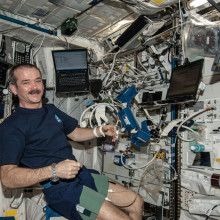
40:35 - Astronaut Chris Hadfield: Life In Space
Astronaut Chris Hadfield: Life In Space
with Col. Chris Hadfield, Commander of International Space Station
So far, Izzie and Katie have explored the beginning of space travel, the marvels of our solar system uncovered by Voyager. But we then we reached a point where Astronauts were - and still are - able to live in space for months at a time. The team were very excited to be joined by Astronaut, Former Commander of the International Space Station and author of three books, Chris Hadfield.
Chris - Oh it was so many things at once, it was a huge amount of work. It was a gigantic thrill. It was a lifetime of dreams coming true. It was a great responsibility but it was even better than I dreamed it. It was all those things all all at the same time.
Katie - Sounds amazing. Now how did the international space station actually come about?
Chris - Well, we've been dreaming about space stations since the very first person did the maths, but it wasn't until the 60s and 70s that we started building early fledgling versions with Skylab and with the Russian Soyuz. And then the Russian space station Mir. But all of those were really just precursors to the International Space Station which is the biggest best most capable spaceship that has ever been built.
Katie - And we were talking about inspiration a little bit earlier on. I've got to ask, how did your love of space begin? Did you always know that you wanted to be an astronaut?
Chris - I deliberately decided to turn myself into an astronaut when I was nine years old. I watched the first two people walk on the moon on July 20th 1969 and that day I just said OK I didn't know that was something that was even possible for especially for a little Canadian kid.
And I thought but if that's the possibility if we could walk on the moon I can turn myself into an astronaut. And so I pursued it from then on and incredibly enough I flew in space three times and ended up commanding the space station.
Katie - So what are some of the biggest challenges about actually living in space, especially as a former commander?
Chris - People think it's physical but that's pretty trivial. The real hard part is mental. It's a huge demand of learning and memory and ability to react to emergency situations. And so it's decades of study and knowing all of the details of your ship and everything else that can happen. And so I studied at it my entire life and from the day that I decided to be an astronaut until I flew in space was twenty six years and most of that was theoretical, technical study and personal preparation. There's all the other things of course - the ability to communicate, speak other languages, keep your body in shape things like that, but far and away the most demanding part of being an astronaut is the mental task that goes along with it.
Katie - What was the hardest thing to get used to, was that also a mental aspect?
Chris - Well it's a tremendous pace of work. You work about 18 hours a day seven days a week for six months, and you don't ever get to choose what you're doing next. There's mission controls all over the place and you know there's one in Houston one in Moscow one in Munich one in Montreal and one in Tokyo. And they're all telling you what to do. Down to five minute segments for the entire six months. So that takes some getting used to, a completely externally dictated life of service. But at the same time if you have two minutes off somehow you can float to the window and watch the entire world going by at five miles a second.
Katie - Wow. I mean that is quite a coffee break isn't it! It is absolutely amazing! Now talking of the work that you were doing, what sorts of experiments are run on the ISS?
Chris - Well we run about 200 experiments simultaneously. Some of them are looking at the world. Since we go around the world 16 times a day and have been for the last 18 years. It's a wonderful way to be a physician to the world, to take its temperature, to look at its conditions, to really try and understand the changes over time.
We have experiments looking out into the universe because there's no atmosphere in the way. So we have telescopes and things on board and then inside you can do all sorts of research where you've taken away gravity. So for how particles behave, how fluids behave, how flame behaves, how the human body behaves, all trying to lay the ground to look further into the solar system. And then finally it's a great place to test new space equipment like how does a toilet work, a carbon dioxide removal system work? How do you keep people psychologically healthy? Where do you test all of that equipment? And we do all those things simultaneously on the ship.
Katie - Wow. OK. So do you have any particular favourite moments?
Chris - Spacewalking is the best moment you can imagine. To put on your protective spacesuit, to open up the hatch and to go outside to be hanging on to the outside of the spaceship with one hand with the whole world pouring by beside you and the three dimensional immensity of the universe all around you.
Next time you're in a swimming pool, get down halfway down in the water and then look down and imagine if the bottom of the pool was infinitely deep below you and can look up and imagine the top of the water was infinitely high above you, and you were suspended in the middle of that. That's what it feels like to be outside on a spacewalk. It's a very humbling but also brand new way to see our place in the world and in the universe.
Izzie - I bet that has a slightly better view than doing it from a pool! So how did you feel going into a spacewalk like that?
Chris - Immensely ready. I'd been training for years, I learned to scuba dive when I was 12, I'd spent hundreds and hundreds of hours developing and inventing that spacewalk. I'd even helped them design the training equipment and models that we would use, the full scale mockups that we use underwater. It had been a huge part of my life for longer than a university degree just to get ready for that spacewalk. So I felt ready for it but also kind of recognizing that this was a peak moment of my life, to go out and be trusted to do this thing. It's very dangerous. It's also just personally and professionally magnificent. So it was a great experience.
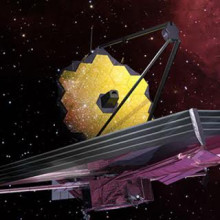
47:03 - The Future of Space Exploration
The Future of Space Exploration
Throughout the show, we've whizzed through the history of exploring our solar system. Izzie asked Chris Hadfield what he thought the future of exploring space will be like. Plus journalist, Stuart Clark, takes us through the future of space exploration.
Chris - I think it will just mirror the extension of the history of exploration of the surface of the earth. You know, we used to all live in Africa and over 70,000 years we've spread everywhere that our technology will take us and allow us to stay, including in the last hundred years living at the South Pole in Antarctica with a pretty pretty high level of comfort. And for the last 18 years living on-board a spaceship orbiting the world continuously up in the International Space Station, so it's really just our own imagination and technology that limits us. I think it will take us from the space station, to orbiting the moon, to the surface of the moon, and not just to explore like we've done but to actually make that part of the normal human experience where people will be living on the moon. It seems fanciful but so did living on the space station or living in Antarctica not very long ago. Once we've sorted out a lot of the technology living on the moon it'll open our ability to go even further - eventually mars and beyond.
Izzie - I was just going to ask, we've heard a lot about exploring Mars so if humans could go there, would you want to explore the red planet?
Chris - Oh of course! And it's not about if, it's just a matter of when - it's not like we can't imagine how. We just have to invent some things to make them trustworthy and safe enough that we would be willing to climb into them and travel that long way. It's not unimaginable, it's just we have to invent a few things first before we're gonna be willing to add that to the list of the places that we live. You have to make it safe enough, to then make it simple enough, to then make it cheap enough to make it worthwhile - and that's where we're headed.
Izzie - Well Chris Hadfield thank you very much! And also with us is Stuart Clark, Stuart would you fancy a trip to Mars?
Stuart - Yes in principle I fancy it! It's just the amount of time it would take. You know, I struggle to get to the supermarket with everything I'm doing at the moment so in principle I would love to go to Mars.
Izzie - Also a six month trip to a supermarket would be pretty gross!
Stuart - Actually that is pretty bad, when you put it like that Mars sounds like a doddle.
Izzie - There are quite a few missions that are looking to Mars, what's going on? What are some of the latest things that we've seen?
Stuart - Just in the last week or so we've had NASA's insight mission landing on the planet, and this is a really interesting scientific mission because it's all about the interior of Mars. It's all about looking inside, seeing how that planet is made, how active it remains today. This is a big, big thing because we think of Mars today as being almost a dead world but there's no guarantee of that. There could be magma on the move down there, which means that in principle you could have the volcanoes come back to life. Looking inside the planet we want to see how dead or alive is Mars.
Izzie - Okay, so that's INSIGHT. But then we've got this other big mission in 2020, so how are they different and who's doing that?
Stuart - Yes, the 2020 mission is the XO Mars rover and that's the European Space Agency's next mission to Mars. This is truly fascinating because it really will look for traces of life on Mars, and that could be present life or it could be extinct life - chemical fossils and fingerprints and things like that.
Izzie - It's very exciting. Earlier we spoke about Voyager, and that really changed our view of our solar system. Would something like this have the same effects, or are there other missions that could create even bigger changes to how we see our nice system?
Stuart - If you were to find evidence of life on Mars I couldn't imagine a bigger scientific discovery at the moment, because you can see whether it looks like earth life or is it completely different? Whichever answer you get, that's really significant for telling us about life on Earth and how unique or not we are, and how we evolved - all of those sorts of fundamental biological questions. Looking beyond XO Mars and into the wider universe, the biggest mission to be looking at is the James Webb Space Telescope. This is the successor, if you like, to the Hubble Space Telescope. James Webb will look into space at infrared wavelengths, so wavelengths that are a bit longer than we can see with our eyes, and this will allow it to look into places that we've never properly been able to look before.
Izzie - So, I mean, when we say that how is that even possible?
Stuart - Because it has longer wavelengths of light that it's looking for, these can penetrate into dusty clouds and nebula close by so we can see young stars and young planets that are forming. It will also be able to look into the very far distant universe where light is stretched by the expansion of the universe out of the visible and into the more infrared wavelengths. It will be looking for the way that galaxies form. It may stand a chance of even seeing possibly the first stars that were there in the universe, which we've never seen before.
Izzie - So it's basically an all seeing, very impressive time machine to an extent.
Stuart - Yeah absolutely. It's a general purpose observatory that will look at the universe in a way we haven't yet been able to look at in this detail. In the past, whenever we've done that we have changed the way we think about the universe.
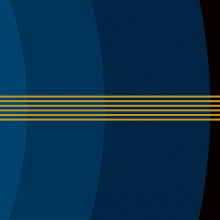
53:12 - Music: Big Big Train - Voyager
Music: Big Big Train - Voyager
with Greg Spawton & David Longdon, Big Big Train
The Naked Scientists had the exclusive play of Big Big Train's upcoming record, "Voyager". Many thanks to Greg Spawton, David Longdon and the rest of the band.
Related Content
- Previous Mission to the Moon
- Next Language development through childhood










Comments
Add a comment